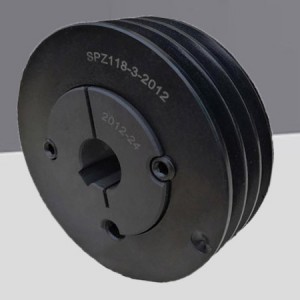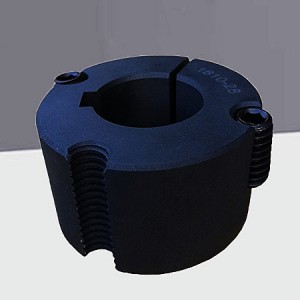Taper Sleeve
products description
The belt pulley is rotating horizontally, so what is needed to hold it in place and keep it from falling off. The belt pulley and the shaft are connected by a key, and Palocean's European standard taper sleeve pulley is much more convenient. What is the working principle of taper sleeve pulley?

The holes where the taper sleeve and the pulley match are half-sided, and the two light holes on the taper sleeve and the two threaded holes on the pulley form a complete hole respectively, and a threaded hole on the taper sleeve forms a complete hole with a light hole on the pulley.

During assembly, two screws are put on the two threaded holes of the pulley, and as the screws are tightened continuously in the threaded holes on the pulley, the thread action pushes the screws to the small end of the tapered holes on the pulley, while the two light holes on the tapered sleeve are not completely machined through, so that when the head of the screw is against the bottom of the light hole, the force is transferred to the tapered sleeve, and the tapered sleeve moves relative to the pulley toward the small end of the tapered holes of the pulley. At this time, because of the taper, the taper sleeve is constantly wrapped tightly around the shaft, and the shaft acts on the taper sleeve, and then on the pulley. In this way, the pulley, taper sleeve and shaft are closely assembled together.
Working Principle
The holes where the taper sleeve and the pulley fit together are half-sided, and the two light holes on the taper sleeve and the two threaded holes on the pulley each form a complete hole, and the one threaded hole on the taper sleeve and the one light hole on the pulley form a complete hole. During assembly, two screws are put on the two threaded holes of the pulley, and as the screws are tightened continuously in the threaded holes on the pulley, the thread action pushes the screws to the small end of the tapered holes on the pulley, while the two light holes on the tapered sleeve are not completely machined through, so that when the head of the screw is against the bottom of the light hole, the force is transferred to the tapered sleeve, and the tapered sleeve moves relative to the pulley toward the small end of the tapered holes of the pulley. At this time, because of the taper, the taper sleeve is constantly wrapped tightly around the shaft, and the shaft acts on the taper sleeve, and then on the pulley. In this way, the pulley, the taper sleeve and the shaft are tightly assembled together.
On the contrary, when disassembling, the screw which is withdrawn from the threaded hole of the pulley is put on the threaded hole of the cone sleeve, and in the process of tightening, the screw moves towards the small end of the cone hole of the pulley, and when the head of the screw is against the bottom of the light hole of the pulley, the force is transferred to the pulley, and then the pulley moves towards the small end of the cone hole of the pulley relative to the cone sleeve, so that the pulley and the cone sleeve are separated from each other. And the cone sleeve is also separated from the shaft because it loses the binding force from the cone hole of the pulley, plus a little elasticity of its own restoration of roundness.
When the taper sleeve connects the pulley to the shaft, a interference fit is formed. The bore of the taper sleeve is keyed to the shaft, and it is through the key that torque and force are transmitted. Although there is no key connection between the taper sleeve and the pulley, positive pressure exists on the joint surface, and the friction generated transmits torque and force.
detail
Taper sleeve is a very common mechanical transmission coupling, taper sleeve can be widely used with pulleys, sprockets, gears and other parts and shaft coupling, taper sleeve can bring high centring accuracy for transmission parts, compact structure, easy installation and other advantages, the following Eifit to everyone on the classification and application characteristics of the taper sleeve!
The taper sleeve is coupled by conical surface compression, so that the inner surface of the taper sleeve and the shaft, and the outer surface and the hub of the coupling produce clamping force between them, relying on the combination pressure between the taper sleeve and the machine (sometimes there is a keyway on the taper sleeve) and the resulting friction to transmit the torque, so as to realize the coupling between the machine and the shaft.

Taper bush for transmission parts is generally greater than 1:20 taper, widely used in transmission structure, such as gears, pulleys, sprockets, timing pulleys, etc., in the practical application often need to be disassembled, such as the installation of gear replacement. Taper sleeve for structural parts is not directly used for belt drive, chain drive, gear drive parts, but is the taper sleeve in the structure of power transmission. The taper of the taper sleeve for structural parts is generally not greater than 1:20, and is used in structures that require high centring accuracy and generally do not need to be disassembled in use.
Features of using tapered bushings for belt pulleys
①High centring accuracy and improved slewing accuracy.
②The parts can easily move on the shaft before locking and positioning, and after locking, it is equivalent to interference fit.
③Uniform load distribution, without shoulder positioning and not easy to occur axial leap.
④Easy to install, disassemble and replace, reducing maintenance costs.
⑤ Compact structure, can be linked to non-weldable materials, such as the connection with aluminum parts.
⑥Part of the taper sleeve is standardized and produced at low cost.














